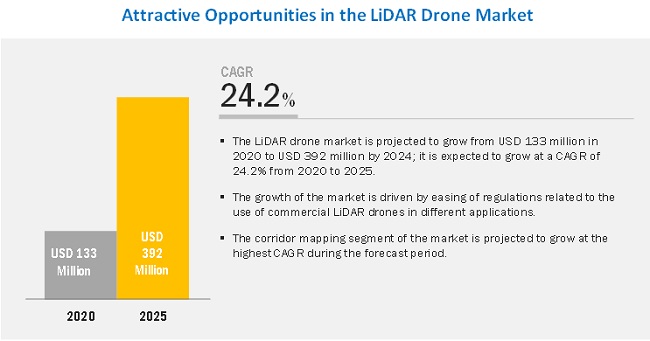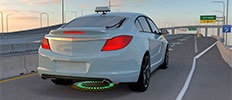The LiDAR drone market is projected to grow from USD 133 million in 2020 to USD 392 million by 2025; it is expected to grow at a CAGR of 24.2% from 2020 to 2025. Key factors fueling the growth of this market include easing of regulations related to the use of commercial drones in different applications and growing demand for LiDAR drones for use in corridor mapping and precision agriculture applications.
LiDAR is a remote sensing method, which employs laser sensors to measure ranges or variable distances of targets. Drones are aircraft that can be piloted autonomously or remotely. LiDAR drones use the light emitted from laser sources to scan the ground and measure the variable distance of targets based on the time taken by the emitted light to return to them.
The LiDAR drone market is diversified, with over 30 companies operating across its value chain. These companies offer both rotary-wing and fixed-wing LiDAR drones. Among types, the rotary-wing LiDAR drones segment is expected to lead the market during the forecast period owing to the flexibility and low cost of these drones. LiDAR drones are equipped with LiDAR lasers, navigation and positioning systems, UAV cameras, etc., which enable them to carry out short-, medium-, and long-range operations. The rising demand for LiDAR drones for corridor mapping and precision agriculture applications is fueling the growth of the market.
In 2019, the LiDAR lasers segment captured the largest share of the LiDAR drone market. This segment is projected to lead the LiDAR drone market during the forecast period. LiDAR lasers are among the main components of LiDAR drones. They are extensively used for carrying out different types of surveys. These lasers offer a field of view (FoV) of up to 360°, which helps surveyors to gather a large amount of data in less time. Moreover, the introduction of 4D LiDAR sensors is expected to drive the market for LiDAR lasers in coming years.

Download PDF Brochure @
https://www.marketsandmarkets.com/pdfdownloadNew.asp?id=128835365
Based on range, the medium-range LiDAR drones segment is projected to grow at the highest CAGR during the forecast period. The major factor contributing to the growth of this segment is the capability of medium-range LiDAR drones to cover large areas without compromising on their price and weight. These drones enable the collection of high-quality data. The easing of regulations regarding the use of commercial drones in different countries is expected to drive the growth of this segment of the market during the forecast period.
Among applications, the corridor mapping segment of the LiDAR drone market is projected to grow at the highest CAGR from 2020 to 2025. The growth of this segment can be attributed to the increasing adoption of LiDAR drones for mapping terrains. These drones are used to survey power lines, oil & gas pipelines, and railway tracks in difficult terrains to optimize their maintenance operations, thereby eliminating the risk to human lives. They save the manpower and the time required for surveying applications. The regulations issued by governments of different countries to mandate the use of LiDAR drones for the creation of digital terrain maps (DTMs) for infrastructure development projects are also fueling the growth of the LiDAR drone market. These mandates are expected to be adopted by a large number of countries in future, thereby leading to the growth of the market in coming years.
In 2019, North America held the largest share of the LiDAR drone market. The dominance of North America in the market can be attributed to the initiatives undertaken by governments of different countries of the region and the increased adoption of LiDAR drones in surveying applications. Phoenix LiDAR Systems (US), Teledyne Optech (Canada), Velodyne LiDAR, Inc. (US), and Geodetics, Inc. (US) are some of the prominent players in the LiDAR drone market in North America. Companies from other regions are also expanding their businesses in North America to cater to the increasing demand for LiDAR drones in the region. For instance, in June 2018, YellowScan opened a new subsidiary, YellowScan Inc., in Salt Lake City (US). Through this expansion, the company enhanced its presence in the LiDAR drone market in the US.
